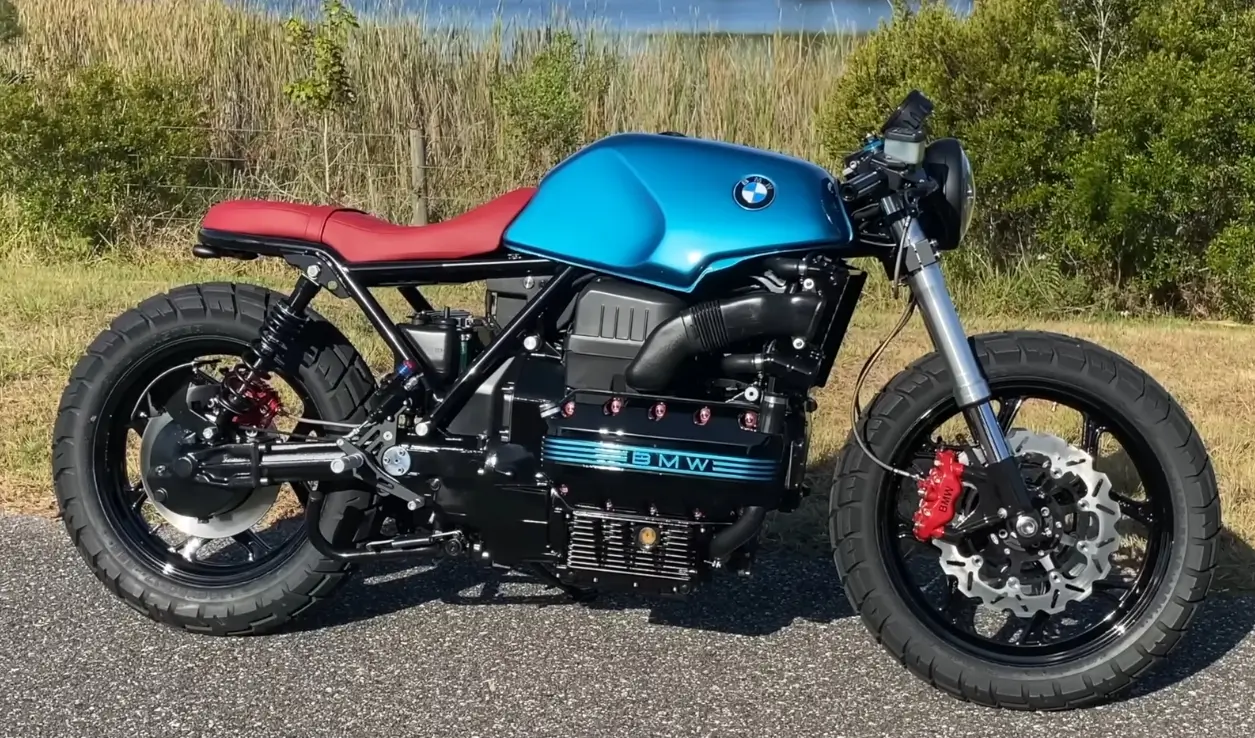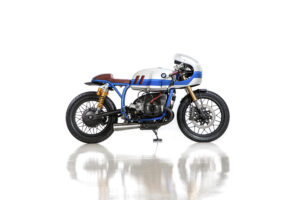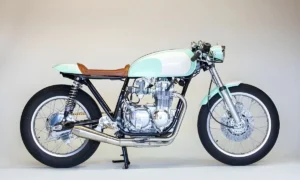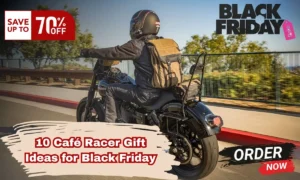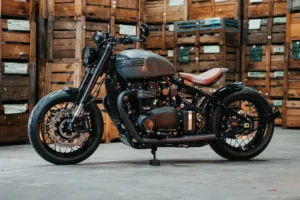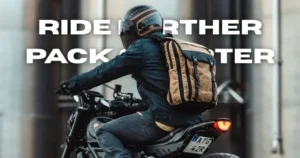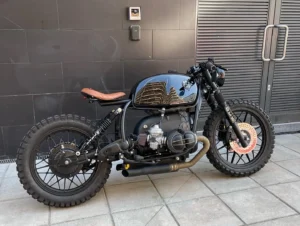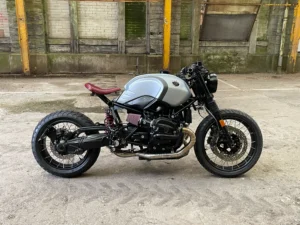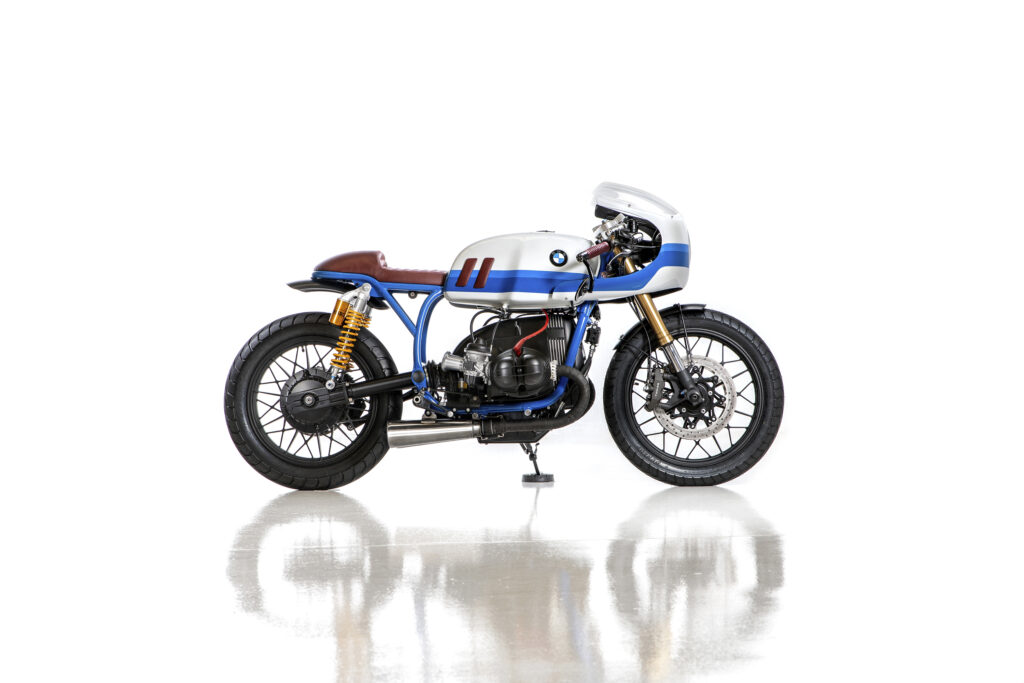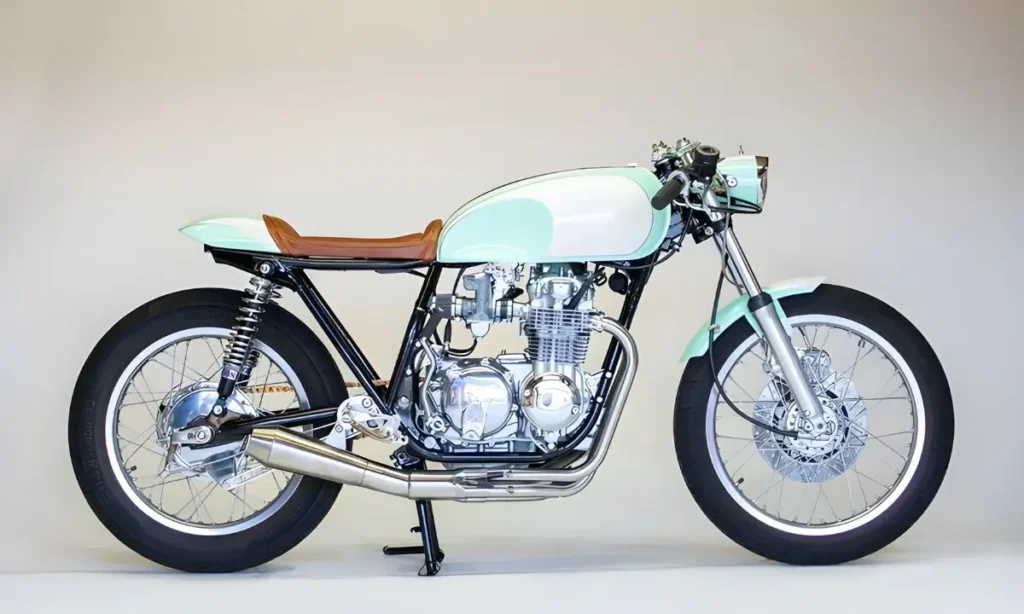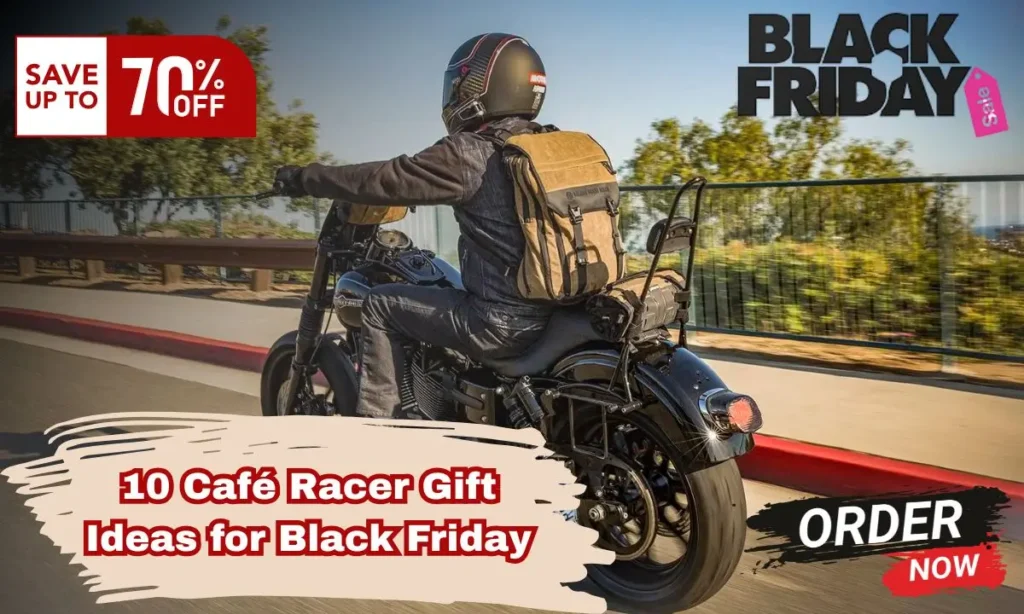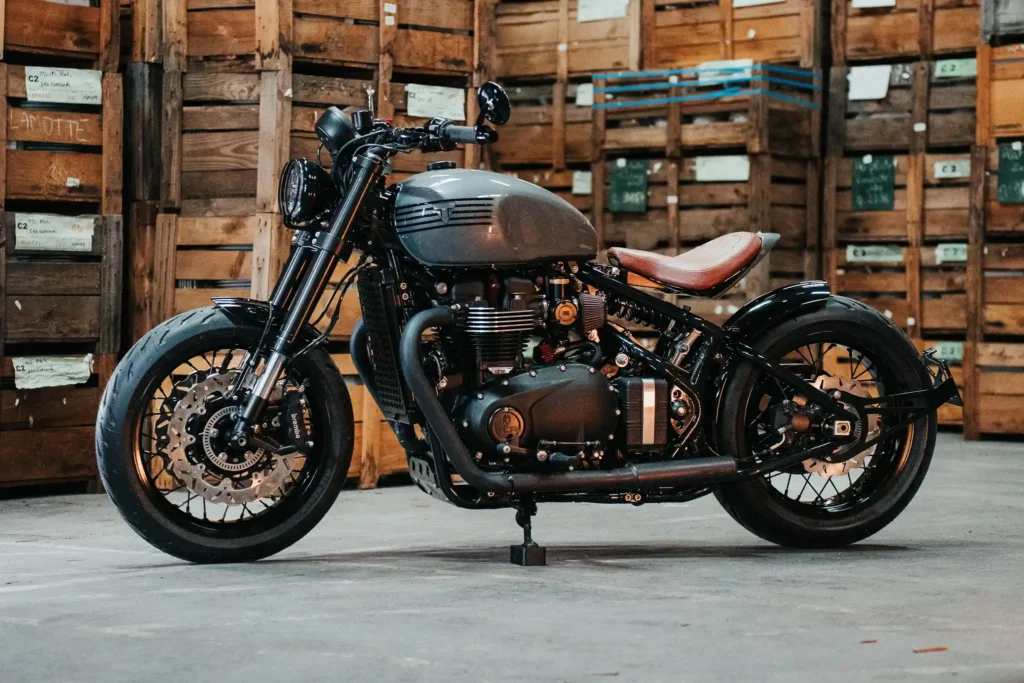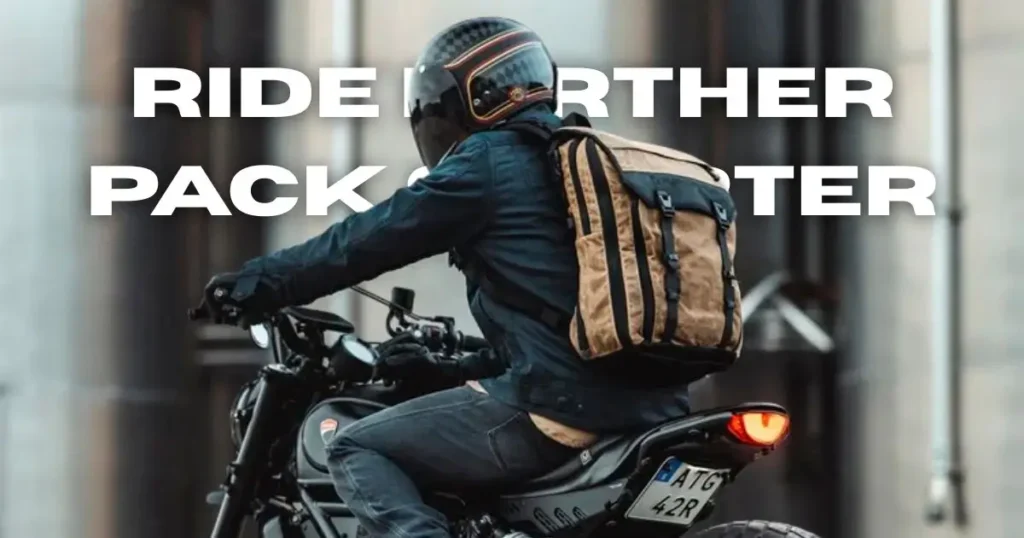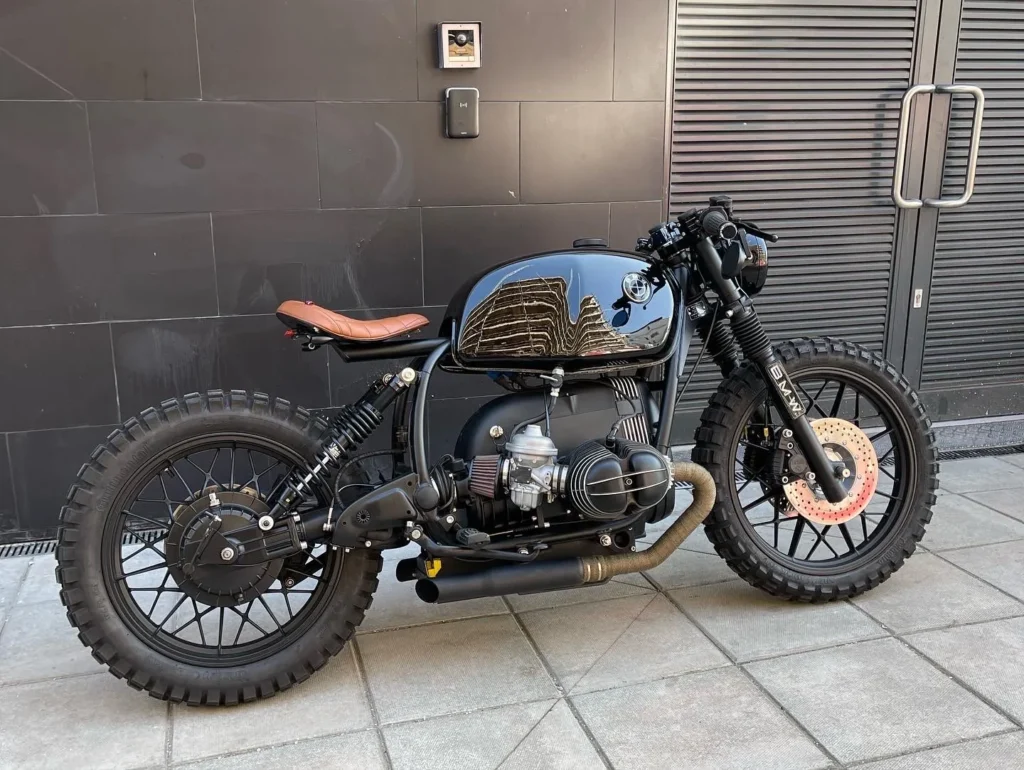Table of Contents
ToggleEver wished you could ride a bike that makes people look twice and has a cool story behind it? A bike that’s one-of-a-kind, just like you? Building a BMW K100 Cafe Racer is your chance to make that happen.
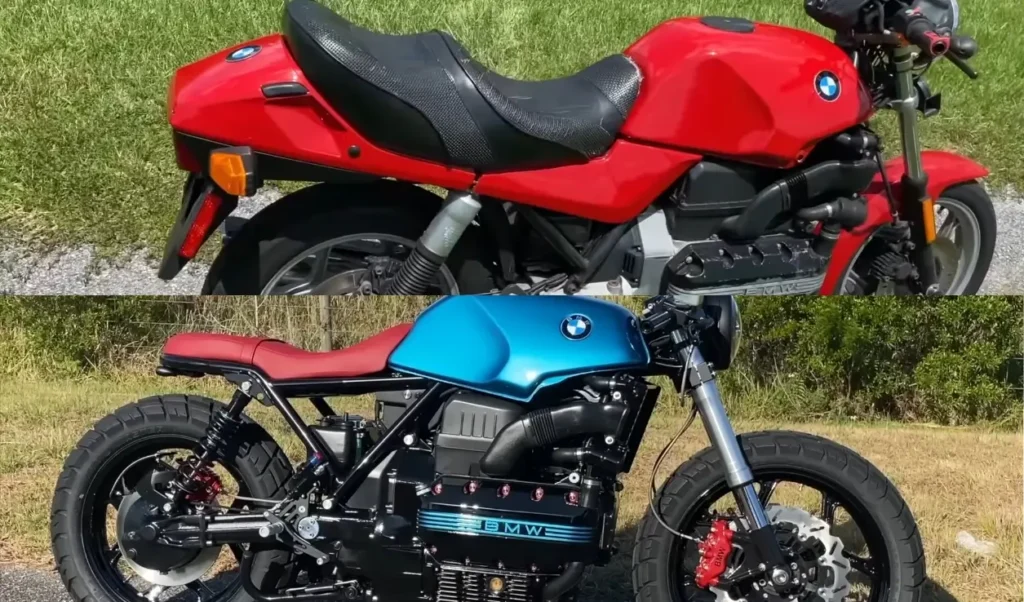
This guide will show you how to turn an old BMW K100 into a super stylish cafe racer. I will cover everything you need to know, from finding the right bike to designing your dream look, and all the steps to build it. Whether you’re a pro with tools or just love bikes, this project is a fun way to be creative, work with your hands, and end up with an awesome ride.
So, are you excited to get started? Let’s use our imaginations and build the cafe racer you’ve always wanted.
Planning the Build
How Much Does a BMW K100 Cafe Racer Build Cost?
How much does building a BMW K100 cafe racer cost? Well, it depends! Here’s a simple guide to help you figure it out:
What affects the cost?
- The starting bike (your K100): A bike in great shape will cost more but need less fixing up. A fixer-upper is cheaper at first, but you’ll likely spend more on parts and repairs.
- Cafe racer kit: These kits give you the parts to transform your bike. They range from basic to fancy, and prices go from a few hundred to a few thousand dollars.
- Extra parts: You’ll need things like lights, a seat, handlebars, and an exhaust. The cost here depends on your style and budget.
- Labor: Doing it yourself saves money, but hiring a pro adds to the cost.
Here’s a rough idea of what you might spend:
- Starting bike: $1,500 – $5,000 or more (depending on how good it is and how old it is)
- Cafe racer kit: $500 – $3,000 or more (depending on the brand and what it includes)
- Extra parts: $500 – $2,000 or more (depending on what you choose)
- Labor: $0 (DIY) or $2,000 or more (professional)
So, what’s the total?
- Basic build: $2,500 – $5,000
- Mid-level build: $5,000 – $10,000
- Fancy build: $10,000 or more
Important Note: These are just estimates. Do your research and make a budget before you start. There are tons of helpful resources online (like forums, blogs, and videos) with detailed cost breakdowns to help you plan your build.
How Long Does a BMW K100 Cafe Racer Build Take (Start to Finish)?
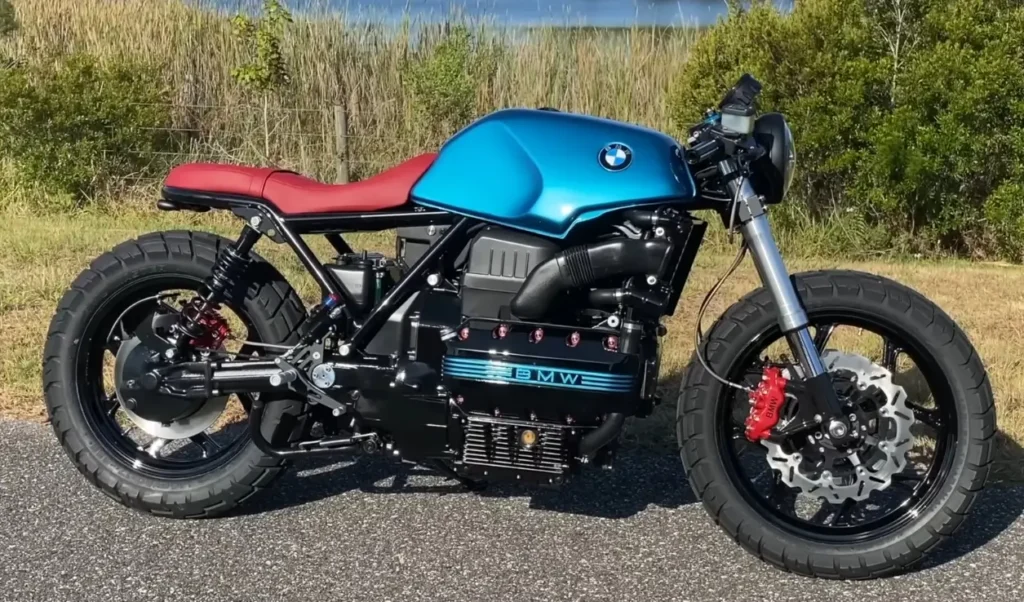
Ever wondered how long it takes to turn a BMW K100 into a head-turning cafe racer? Let’s break it down into simple steps:
What can affect the build time?
- Your experience: Seasoned mechanics will finish faster than beginners.
- How much you change: Small tweaks take less time than major overhauls.
- Finding parts: Having everything ready is quick, but waiting for custom parts can cause delays.
- Your schedule: Full-time work is faster than just weekends.
Here’s a rough timeline for each stage:
- Planning and Design: (1-4 weeks)
- Research, sketch ideas, gather parts, and plan any custom additions.
- Disassembly: (1-2 weeks)
- Take the bike apart and assess its condition.
- Frame Work: (2-8 weeks)
- Cut, weld, and build custom parts like the seat.
- Engine and Performance: (2-6 weeks)
- Fine-tune the engine, upgrade suspension, and work on brakes.
- Electrical Work: (1-4 weeks)
- Rewire, add new lights and gauges.
- Paint and Polish: (1-4 weeks)
- Make the frame, tank, and other parts look amazing.
- Assembly: (2-6 weeks)
- Put everything back together, making sure it fits and works perfectly.
- Testing and Tuning: (1-4 weeks)
- Take test rides, adjust the engine and suspension for optimal performance.
So, how long will it take overall?
- Beginner: 6-12 months
- Some Experience: 3-6 months
- Expert/Pro: 1-3 months
Remember, this is just a guide. If you’re dedicated and have everything ready, you might finish sooner!
Important Tip: Building your cafe racer should be fun! Don’t worry if it takes longer than expected. The joy of riding your unique creation will be worth it!
What Are the MUST-HAVE Mods for a BMW K100 Cafe Racer Build?
Want to turn your BMW K100 into a real showstopper cafe racer? Here are the key changes that’ll give it that cool, classic look:
- Seat and Back End:
- Get a slim, simple cafe racer seat and a matching back end.
- You can choose a single seat or one for two people.
- Make the back shorter and higher for a sporty look.
- Handlebars:
- Swap the old handlebars for lower ones that clip onto the forks.
- This gives you a more aggressive riding position, better control, and a cooler look.
- Rear Shocks:
- Get better rear shocks to improve the ride and lift the back end.
- This makes the bike look like a cafe racer.
- Front Forks:
- Think about changing the front forks to newer ones that are upside down or adjustable. This makes the bike handle better and look sportier.
- You can also fix up and shorten the original forks.
- Lights:
- Replace the big headlight with a smaller, round one that looks better on a cafe racer.
- Use LED turn signals and a simple taillight for a clean look.
- Exhaust:
- Get a shorter, sportier exhaust to boost performance and make the bike look awesome.
- There are lots of options to choose from, so find one that sounds and looks the way you want.
- Tires:
- Use high-performance tires for better grip and control, especially if you plan on racing or riding on winding roads.
- Paint:
- A fresh coat of paint in a classic color (like black, white, or silver) can transform the bike.
- Add racing stripes or your own designs to make it unique.
Extra Upgrades (If You Want):
- Move the footpegs back for a sportier riding position.
- Replace the airbox with individual velocity stacks for better airflow and a tougher look.
- Swap the old gauges for simple ones or a digital display.
Remember, this is just a starting point! The best part about building your own bike is that you can make it exactly how you want.
Initial Preparation
Where Can I Find the Perfect BMW K100 Donor Bike for My Cafe Racer Build?
- Online marketplaces like eBay, Craigslist, or Facebook Marketplace.
- Local classified ads in newspapers or online forums.
- Motorcycle auctions, both online and in-person.
- Forums dedicated to BMW motorcycles, like BMW MOA or ADVrider.
By taking the time to look in all these different spots, you’ll have a much better chance of finding the perfect K100 for your cafe racer project.
What Model Year Features Should I Consider When Choosing a BMW K100 for My Cafe Racer Build?
If you’re looking for a BMW K100 to transform into a cafe racer, here’s the good news: it doesn’t really matter which year you choose! The K100 stayed pretty much the same from 1983 to 1992. But there are a couple of tiny things to keep in mind:
- Older models (1983-1987): These bikes have slightly different wires, so if you’re planning to mess around with the electrical stuff, you might need to make some changes.
- Newer models (1988-1992): These bikes have a newer fuel pump, which might be a bit more dependable.
But honestly, the most important thing is finding a K100 that’s in good shape. Look for one with a strong engine and frame – those are the key parts for any custom build.
What Should I Look for When Checking a BMW K100 Donor Bike?
When checking out a potential BMW K100 donor bike for your cafe racer project, here’s what to look for:
Engine:
- Start it up: Listen for any strange noises like knocking or rattling. It should start easily and idle smoothly.
- Check for leaks: Look for oil or coolant leaks around the engine, hoses, and gaskets.
- Check the oil: Make sure the oil level is correct and that it looks clean.
- Compression test: If possible, perform a compression test to check the engine’s health.
Frame and Body:
- Check for rust or damage: Look for any signs of rust or damage to the frame, especially around the steering head and swingarm.
- Check the alignment: Make sure the frame is straight and that the wheels are aligned properly.
- Inspect the bodywork: Look for any cracks, dents, or missing parts.
- Electrical system: Check all the lights, turn signals, and horn to make sure they work.
Other components:
- Brakes: Check the brake pads and rotors for wear. Make sure the brakes feel firm and responsive.
- Suspension: Check the forks and shocks for leaks or damage. Bounce on the bike to see if the suspension feels smooth.
- Tires: Check the tire tread depth and look for any signs of damage or uneven wear.
- Chain and sprockets: Check the chain for slack and wear. Inspect the sprockets for any damage or sharp teeth.
- Exhaust: Check for any holes or leaks in the exhaust system.
Paperwork:
- Title: Make sure the bike has a clean title with no liens or salvage history.
- Maintenance records: If available, ask to see the bike’s maintenance records to get an idea of how well it has been cared for.
Remember, the best K100 for your cafe racer project is the one in the best overall condition you can find. Don’t be afraid to walk away if you have any doubts about a particular bike. Take your time, do your research, and you’ll find the perfect K100 to transform into your dream cafe racer.
What Legal Considerations and Documentation Are Necessary?
Make sure the bike isn’t stolen and has the correct ownership papers. Check your local rules about any changes made to the bike and if it meets environmental standards. Get all the important papers together, like the ownership document, proof of purchase, and any records of repairs or maintenance.
Remember, these steps might be slightly different depending on where you live, so it’s always a good idea to check the specific requirements in your area.
How Do You Perform VIN Checks and Title Transfers?
Check the bike’s history online using its Vehicle Identification Number (VIN). Make sure the VIN on the bike matches the one on the paperwork. If you’re transferring ownership, go to your local Department of Motor Vehicles (DMV) and follow their steps. Fill out all the forms correctly and pay the required fees.
What Tools Do You NEED for a BMW K100 Cafe Racer Build?
For a BMW K100 Cafe Racer build, you will need these essential tools :
- Socket Set: Metric sockets for various nuts and bolts on the bike.
- Wrenches: Combination wrenches for tightening bolts.
- Allen Keys/Hex Keys: For hexagonal socket bolts commonly found on motorcycles.
- Screwdrivers: Both flathead and Phillips head for various screws.
- Pliers: Needle-nose pliers, slip-joint pliers, and vice grips for gripping and turning.
- Torque Wrench: For precise tightening of bolts to manufacturer specifications.
- Multimeter: For electrical diagnostics and testing.
- Bike Stand: Lifts the bike off the ground for easier access to components.
- Chain Breaker: If modifying the chain or sprockets.
- Safety Gear: Gloves, safety glasses, and ear protection.
These tools should cover most tasks involved in disassembling, modifying, and reassembling a BMW K100 into a Cafe Racer. Depending on your specific modifications, you may need additional specialized tools.
Dismantling the Bike
Taking apart a BMW K100 motorcycle is like solving a puzzle – it takes careful planning, good tools, and attention to every detail. Whether you’re fixing something up, making it your own, or just need to reach the inside parts, doing it step-by-step is the key to getting it right.
Here’s Your Guide to Taking it Apart:
Get Ready:
- Tools: Make sure you have the right tools like sockets, wrenches, screwdrivers, pliers, and a torque wrench.
- Work Area: Find a clean, well-lit spot with plenty of space to move around the bike.
- Instructions: Check the official BMW K100 guide for specific directions and how tight to make bolts.
- Safety: Wear safety glasses and gloves to protect yourself.
First Steps:
- Power Off: Disconnect the battery – black wire first, then red.
- Drain Fluids: Empty out the old oil, coolant, and brake fluid.
- Remove Outer Parts: Carefully take off the front cover (fairing), seat, gas tank, and any other parts on the outside.
Big Parts:
- Exhaust: Unhook and take off the exhaust pipes and muffler.
- Wires: Disconnect the wires, sensors, and other electrical parts. Make sure to label everything so you remember where it goes back.
- Fuel: Take off the gas tank, fuel lines, and parts for fuel like the carburetor.
- Cooling: Unhook and take off the radiator, hoses, and the thermostat.
- Wheels: Take off the back wheel, swingarm, and final drive.
- Front: Take off the forks, handlebars, and front wheel.
- Engine: Carefully disconnect the parts holding the engine and lift it out.
Take it Apart Further:
- Gears: Open up the gear box and look at the gears, bearings, and seals.
- Clutch: Take out and look at the clutch plates, pressure plate, and the clutch basket.
- Engine (If Needed): If you need to, open up the engine to get to the parts inside for fixing or rebuilding.
Keep Track of the Parts:
- Labeling: Label every part with its name, where it goes, and anything important you need to remember (like how worn it is or how tight to make the bolts).
- Storage: Put the parts in labeled boxes, bags, or containers. Keep similar parts together.
- Photos: Take pictures of the bike before and while you take it apart. This helps you remember how to put it all back together.
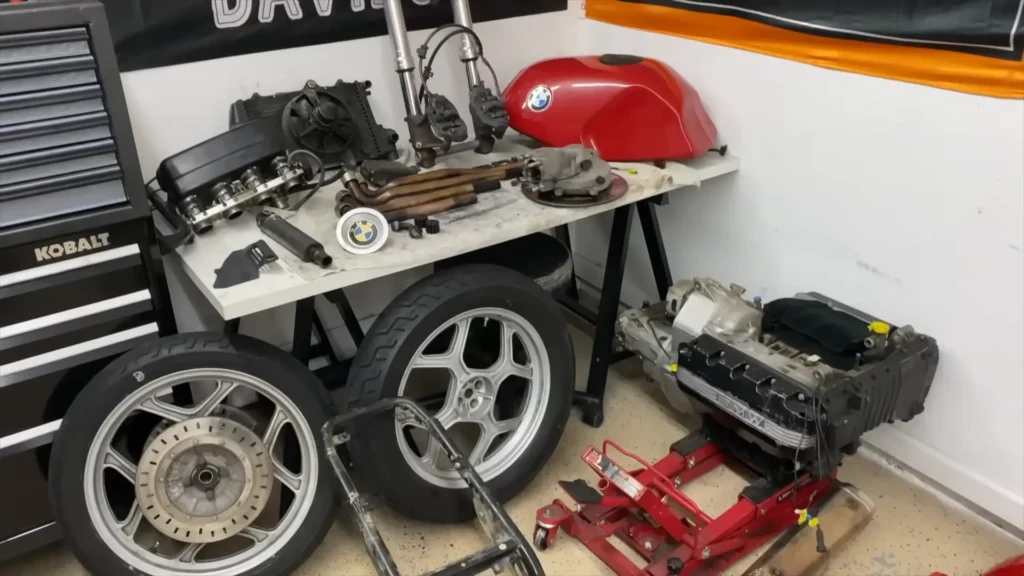
How Do You Identify Reusable Components?
Look closely at every part to see if it’s worn out, broken, or messed up in any way. For parts like the alternator, starter motor, and carburetors, clean them up and make sure they’re working properly. Keep the parts that are in good shape, and make a plan to replace the ones that are too worn or broken to use.
How Do You Modify the Frame for a Cafe Racer?
1. Stripping and Cleaning the Frame
- Take it apart: Remove all the parts that are attached to the frame, like the engine, wheels, and seat.
- Get rid of the old stuff: Use a wire brush or sandpaper to remove any old paint, rust, or grime.
- Degrease: Clean the frame with a degreaser to remove any oily residue.
2. Subframe Design and Fabrication
- Purpose: The subframe supports the seat, rear fender, and tail light. It’s key to the cafe racer look.
- Design options:
- Loop style: A simple loop that follows the lines of the main frame.
- Hoop style: A more complex design with a raised hoop for a sportier look.
- Custom: Create a unique design that matches your vision.
- Building it: You can build a subframe from scratch using steel tubes or modify an existing one.
3. Choosing the Right Subframe Design
- Bike style: The design should complement the overall style of your cafe racer.
- Seat style: The subframe needs to be compatible with the seat you choose.
- Strength and safety: The subframe must be strong enough to support the rider and any additional weight.
4. Welding Techniques
- Safety first: Wear protective gear like a welding helmet, gloves, and long sleeves.
- Type of welding: TIG welding is often preferred for its clean welds.
- Practice: If you’re new to welding, practice on scrap metal before working on the frame.
- Professional help: Consider hiring a professional welder if you’re unsure of your skills.
5. Seat Selection and Customization
- Style: Cafe racer seats are typically slim and low-profile.
- Types:
- Solo seat: A single seat for a minimalist look.
- Tuck and roll: A classic cafe racer seat with a ribbed pattern.
- Custom: Create a unique seat that fits your style.
- Materials: Leather is a popular choice for its durability and looks.
- Comfort: Don’t forget to consider comfort when choosing a seat. Foam padding can make a big difference.
Important Considerations
- Materials: Steel is the most common material for motorcycle frames and subframes.
- Comfort: While cafe racers are known for their sporty look, don’t sacrifice comfort for style.
- Safety: Make sure your modifications don’t compromise the safety of your bike.
Additional Tips
- Research: Look at pictures of other cafe racers for inspiration.
- Plan: Sketch out your design before you start building.
- Take your time: Don’t rush the process. A well-built cafe racer is worth the effort.
How Do You Overhaul and Upgrade the Engine?
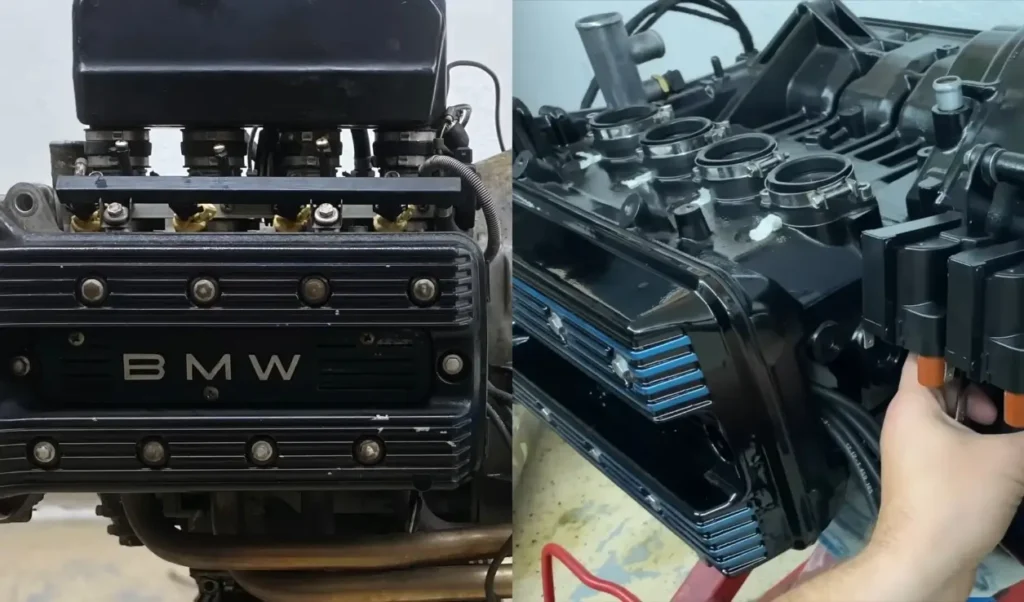
Common Issues and Fixes for the BMW K100 Engine:
- Worn-out rings around the pistons: This can make the engine lose power and burn oil.
Fix: Replace the rings.
- Leaky seals around the valves: This can make the engine burn oil and smoke.
Fix: Replace the seals.
- Air leaks: This can make the engine run rough and not perform well.
Fix: Find and fix the leaks.
How Can You Enhance Engine Performance?
- Better air filter: Lets more air into the engine for better power.
- Different exhaust system: Helps the engine get rid of exhaust gases more easily for more power.
How Should You Maintain the Transmission?
- Change the oil regularly: Keeps the parts inside slippery and prevents wear.
- Check how the clutch is adjusted: Make sure the gears change smoothly.
What Should You Inspect and Repair in the Transmission?
- Worn gears: Check for unusual noises or difficulty shifting.
- Clutch wear: Check for slipping or difficulty engaging.
- Seals and gaskets: Check for leaks.
How Do You Adjust Gear Ratios?
Changing gear ratios is a complex job and usually done to fine-tune performance for specific needs like racing. It’s best to leave this to a professional mechanic.
Electrical System
Simplifying the Wiring Harness:
- Get a wiring diagram: This will help you identify what each wire does.
- Remove unneeded wires: Get rid of wires for parts you’re not using (turn signals, extra lights, etc.).
- Clean and organize: Bundle wires together neatly and use electrical tape or heat shrink tubing to protect them.
Key Electrical Components:
- Headlight: For seeing at night.
- Taillight/Brake light: For safety, so people can see you.
- Ignition switch: To start and stop the engine.
- Battery: To power everything.
How Do You Choose and Place the Battery?
- Size and type: Choose a battery that fits your space and power needs. Smaller, lightweight batteries are often preferred for cafe racers.
- Placement: Many people put the battery under the seat or in a custom-made box. Make sure it’s secure and won’t move around.
How Can You Upgrade the Charging System?
- Check your current system: If you’re not adding a lot of extra lights or accessories, your stock charging system might be fine.
- Upgrade if needed: If you’re adding more electrical components, you may need a stronger alternator or voltage regulator to keep the battery charged.
Important Note: If you’re not comfortable working with electrical systems, it’s always best to consult a professional.
How Do You Upgrade Suspension and Brakes for Better Performance?
Upgrading Suspension and Brakes on a BMW K100
Front Fork Upgrades:
- Options:
- Rebuild: If your forks are in good condition, just clean, refresh the seals, and adjust the oil/springs.
- Replace: Upgrade to newer forks from other BMW models (like R nineT) or aftermarket brands (like USD forks).
- Fork Oil and Springs:
- Oil: Choose the weight (thickness) based on your riding style and weight.
- Springs: Match the spring rate to your weight and how you want the bike to handle.
Rear Suspension Options:
- Shock Absorber: Upgrade to a better quality shock from another BMW model or aftermarket brand (like Öhlins or YSS). Consider adjustable options for fine-tuning.
Setting Up Suspension:
- Sag: Adjust the preload (how much the springs are compressed when you’re sitting on the bike) to get the right amount of sag for your weight.
- Damping: Adjust the rebound and compression damping (how fast the suspension moves) to get the ride feel you want.
Brake Overhaul:
- Clean: Thoroughly clean all parts.
- Replace: Replace worn or damaged parts (seals, pads, etc.).
- Bleed: Bleed the system to remove air bubbles and ensure good brake pressure.
Brake Upgrades:
- Calipers: Upgrade to calipers from other BMW models or aftermarket brands. Look for calipers with more pistons for stronger braking.
- Discs: Upgrade to larger or better quality discs for improved stopping power.
- Lines: Upgrade to stainless steel braided brake lines for a better feel and less expansion under pressure.
- Fluid: Use high-quality brake fluid and change it regularly.
Remember: Suspension and brake work can be tricky. If you’re not confident, it’s always best to consult a professional.
What Are the Best Wheel and Tire Options for a BMW K100 Cafe Racer?
Spoked or Alloy Wheels:
- Spoked: Classic look, lighter weight.
- Alloy: More modern look, a wider range of sizes and styles.
- Choice: Personal preference, consider the overall style you want for your cafe racer.
For Know More Read our Blog [Spoke Wheels Vs Alloy Wheels – Which is Better For Cafe Racer?]
Sizing Considerations:
- Front: Stock size is 18-inch. You can usually go up to 19 inches without major modifications.
- Rear: Stock size is 17-inch. Wider options are available but may require modifications to the swingarm or rear fender.
- Tire Width: Choose a tire width that fits your rims and provides the desired handling and look.
Selecting the Right Tires:
- Type: Consider the type of riding you’ll do. Sport tires offer good grip on dry roads, while touring tires offer longer tread life and better wet-weather performance.
- Brand: Choose a reputable brand with a good track record for quality and performance.
- Tread Pattern:
- Sport: More aggressive tread for better cornering grip.
- Touring: Smoother tread for longer mileage and comfort.
Ensuring Sizing and Compatibility:
- Check fitment guides: Look for information from tire manufacturers or online forums to see what sizes fit your bike.
- Consult a professional: If you’re unsure, ask a mechanic or tire specialist for advice.
Remember: Proper wheel and tire choice is crucial for safety and handling. Make sure your tires are properly inflated and in good condition
How Do You Choose and Install the Perfect Exhaust?
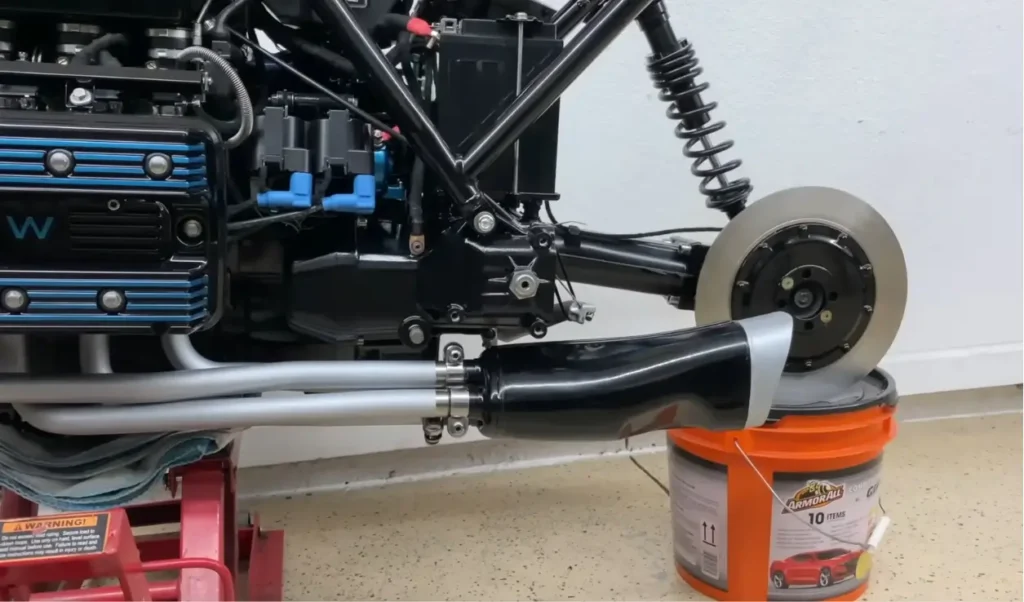
1. Choosing Your Exhaust Design:
- 4-into-1: One pipe combining exhaust from all cylinders. This design often gives you a boost in performance.
- 4-into-2: Two pipes, one for each side of the engine. This is a classic cafe racer style.
- Individual pipes: One pipe per cylinder. These are loud and give your bike a unique look.
Think about this: Which look and sound do you prefer? If performance is your top priority, the 4-into-1 design is usually a good choice.
2. Balancing Performance and Looks:
- Performance: The pipe’s diameter and material (usually stainless steel) affect how well the engine breathes.
- Looks: Choose a style that fits the overall vibe of your bike. Do you want sleek and minimalist or something more eye-catching?
- Sound: Listen to sound clips online to get an idea of how different exhausts sound before you buy.
3. Know the Rules: Legal Noise Limits
- Check local laws: Noise limits can vary depending on where you live.
- Baffle it up: A removable baffle can help you quiet down your exhaust if you need to.
4. Installing Your Exhaust:
- Take off the old exhaust.
- Check the fit: Before tightening anything, make sure the new exhaust fits snugly.
- New gaskets: Use new gaskets between the exhaust and engine to prevent leaks.
- Tighten the bolts: Use a torque wrench to tighten the bolts to the right tightness, so they don’t come loose.
5. Dealing with Heat: Header Wrap
- Header wrap: This is insulation for your exhaust. It can help your engine perform better and protect nearby parts from getting too hot.
- Be careful: Header wrap can trap moisture and cause rust. It might also void some warranties, so check before you wrap.
6. Mounting Your Exhaust:
- Mounts: Use the brackets that came with your exhaust, or make your own, to attach it securely to the frame.
- Clearance: Make sure your exhaust doesn’t get too close to the rear tire or any other parts of the bike.
- Safety first: Double check that the exhaust doesn’t get hot enough to burn you or your passenger.
How Do You Modify the Fuel System for a Cafe Racer?
Fuel Tank: Custom or Original (OEM)?
- Custom Tanks: Offer a unique look and can be tailored to your cafe racer’s design.
- OEM Tanks: The original tank may be easier to fit and function well with your bike’s system.
Think about this: Do you want a one-of-a-kind look, or do you prefer a simpler modification process?
2. Fuel Lines: The Path to Power
- Routing: Keep fuel lines away from hot areas and moving parts.
- Material: Use high-quality fuel-resistant hose clamps to secure them properly.
- Length: Make sure lines are the right length to avoid kinks or stretching.
Tip: Check for leaks regularly! A leaking fuel line is a safety hazard.
3. Carburetors vs. Fuel Injection: The Great Debate
- Carburetors: Simpler, easier to work on, and offer a classic look.
- Fuel Injection: More efficient, better fuel economy, and easier starting in cold weather.
Consider this: Are you comfortable tinkering with carburetors, or do you want a more modern system?
Click to know more : [Fuel Injection Vs Carburetor: Which Is the Best for Your Cafe Racer?]
4. Tuning and Maintenance: Keeping the Fuel Flowing
- Carburetors: Need regular cleaning and adjustments to keep them running smoothly.
- Fuel Injection: Less hands-on maintenance but may need occasional professional tuning.
Regular Checks:
- Clean the tank: Remove any rust or debris to prevent clogs.
- Check for leaks: Inspect fuel lines and fittings regularly.
- Replace filters: Change the fuel filter as needed to keep the fuel system clean.
Safety First: Always work in a well-ventilated area and take precautions when working with fuel.
How Do You Customize the Look of Your BMW K100 Cafe Racer?
Choosing Materials for Your Fairings and Panels:
- Fiberglass: This is a good option if you want something light, easy to shape, and budget-friendly. It’s like a blank canvas for your ideas!
- Carbon fiber: If you’re looking for the lightest and strongest option, this is the one. But be prepared to pay a bit more for it.
- Aluminum: This is a tough material that can be shiny or painted. It’s a good choice if you’re handy with tools or have a friend who is.
Making Your Custom Parts:
- Plan it out: Start with a sketch or use a computer program to picture how you want your bike to look.
- Make templates: Use cardboard or foam to create models of your parts. This helps you see if they’ll fit before you start cutting and shaping the real materials.
- Get expert help: If you’re not confident in your DIY skills, a professional can help you make your dream parts.
Paint & Finish Options:
- Base coat/clear coat: This is the most popular choice. It’s durable and gives your bike a shiny finish.
- Single-stage paint: This is a simpler process, but the paint won’t last as long.
- Powder coating: This is a tough coating that comes in different colors. It’s very durable, but you won’t have as many color choices.
- Custom paint jobs: If you want a one-of-a-kind look, you can get creative with airbrushing, pinstriping, and other techniques.
Adding Decals and Details:
- Clean it up: Make sure your bike is clean and free of dirt and grease before you apply any decals.
- Choose quality decals: Vinyl decals made for outdoor use will last longer.
- Add those finishing touches: Polish your bike, wax it, and add any protective coatings you like.
Remember: There are no rules when it comes to customizing your cafe racer. Go wild with your creativity and make it truly your own!
How Do You Reassemble and Test Your BMW K100 Cafe Racer?
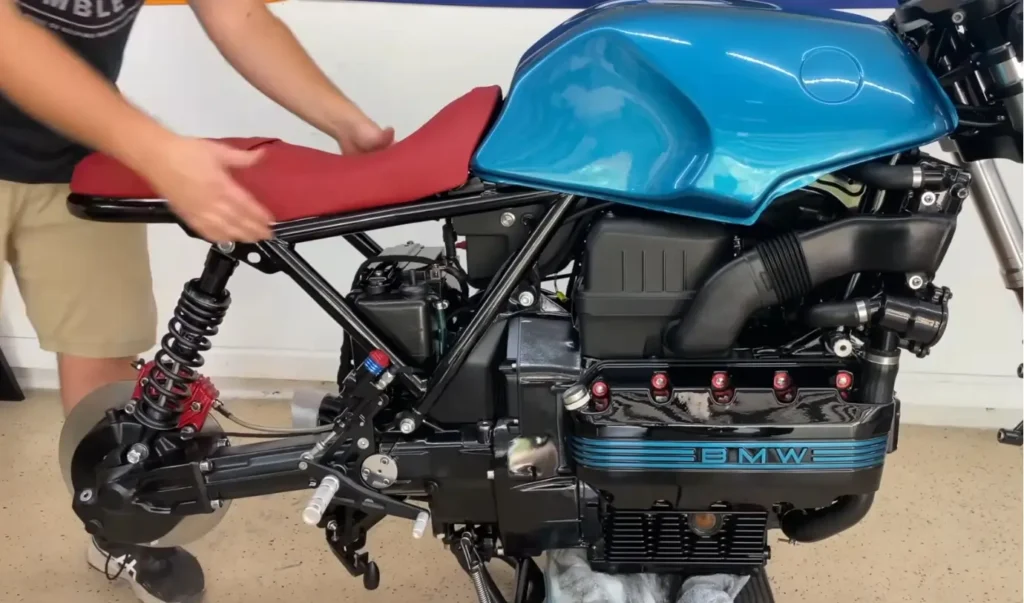
Step-by-Step Reassembly:
- Frame: Start with the main frame, ensuring all bolts and fittings are secure.
- Engine: Carefully place the engine back into the frame, aligning it properly.
- Wheels and Suspension: Attach the wheels and tighten the axle nuts. Connect the suspension components.
- Brakes: Install the brake calipers and connect the brake lines.
- Electrical: Connect all electrical wires, ensuring proper connections and grounds.
- Fuel System: Reattach the fuel tank and connect the fuel lines.
- Controls: Install the handlebars, levers, and foot controls.
- Exhaust: Attach the exhaust system.
- Bodywork: Put on any fairings, seat, or other body panels.
Torque Specifications:
Refer to your motorcycle’s service manual for the correct torque values for each bolt and nut. Using a torque wrench is crucial to prevent overtightening or under-tightening.
Pre-Ride Checks:
- Tire Pressure: Check and adjust tire pressure according to the manufacturer’s recommendations.
- Brakes: Test the brakes for proper operation.
- Lights: Check all lights (headlight, taillight, turn signals) to ensure they work.
- Chain Tension: If your bike has a chain, check and adjust the tension as needed.
- Fluid Levels: Check engine oil, coolant, and brake fluid levels.
Fluids and Lubrication:
- Oil Change: Perform an oil change before your first ride after reassembly.
- Chain Lubrication: If applicable, lubricate the chain with proper chain lube.
Initial Test Ride:
Start with a short ride in a safe, controlled environment. Gradually increase speed and test the brakes, steering, and suspension. Listen for any unusual noises.
Common Issues:
- Leaks: Check for oil, coolant, or fuel leaks after the initial test ride.
- Loose Bolts: Ensure all bolts and fittings are still secure.
- Electrical Problems: If any lights or electrical components don’t work, troubleshoot and fix the issue.
Fine-Tuning Adjustments:
- Suspension: Adjust the suspension settings (preload, compression, rebound) to your preferences.
- Chain Tension: Fine-tune the chain tension if needed.
- Brakes: Adjust the brake lever and pedal positions for comfort and control.
By following these steps and paying attention to detail, you can safely reassemble and test your cafe racer, ensuring a smooth and enjoyable riding experience.
What Should I Keep in Mind After Completing My BMW K100 Cafe Racer Build?
After completing your BMW K100 cafe racer build, there are several essential things to keep in mind to ensure a safe, enjoyable, and legal riding experience:
Safety First:
- Double Check Everything: Before you ride, ask a motorcycle expert to give your bike a quick look-over to make sure everything is safe and working right.
- Get Legal: Make sure your custom bike has all the right paperwork and insurance, just like any other motorcycle.
- Gear Up: Always wear a helmet, gloves, jacket, and boots to stay safe on the road.
Taking Care of Your Bike:
- Regular Checkups: Just like going to the doctor for a checkup, your bike needs regular maintenance. Change the oil, filters, and check the brakes, chain, and tires.
- Keep it Clean: A clean bike is a happy bike! Wash it regularly to protect the paint and prevent any rust.
- Store it Safely: When you’re not riding, keep your bike in a cool, dry place, ideally inside a garage or under a cover.
Riding Tips:
- Take it Easy at First: If your bike has a new or rebuilt engine, follow the instructions to break it in gently.
- Get to Know Your Bike: Spend some time getting used to how your cafe racer handles and feels on the road.
- Watch the Weather: Be careful when riding in different weather conditions and adjust your riding style accordingly.
Have Fun with Your Cafe Racer:
- Show it Off: Take your bike to motorcycle shows, and rallies, or just hang out with other riders to share your cool creation.
- Join the Community: Connect with other BMW K100 cafe racer fans online or in-person to get tips and share stories.
- Make it Your Own: Add your own personal touches to your bike with cool accessories, a custom paint job, or performance upgrades.
Remember, building a cafe racer is an exciting adventure. Enjoy fine-tuning and making your bike truly unique!
Conclusion
To sum it up, turning a BMW K100 into your own cafe racer is a fun project full of imagination and hard work. This guide takes you through the steps of planning, building, and finally riding your dream motorcycle. Whether you’re good with tools or just starting out, the joy of riding something you built yourself makes it all worth it. So let your imagination soar and start building your own unique BMW K100 cafe racer today!

